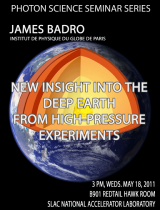Speaker: James Badro, Institut de Physique du Globe de Paris
Scientific researcher at the CNRS at the l'Institut de Minéralogie et de Physique des Milieux Condensés (IMPMC, UMR CNRS 7590, Université Paris 6) and at the Institut de Physique du Globe de Paris (IPGP) since September 1999. Affiliated Faculty Scholar at Laurence Livermore National Laboratory, California, USA.
Program Description
The composition and dynamics of Earth's deep interior is an open question in Earth sciences. Seismological studies offer remote sensing tools that allow for the study of physically inaccessible or unsampled parts of the Earth (core and deep mantle). They provide radial distribution of sound velocity, density, and compressibility profiles, as well as tomographic images (of the same quantities) and cross-sections of the Earth. In order to interpret these images in terms of composition, temperature, and dynamics, we need to put forth mineralogical and geochemical models that are in accord with the seismological models. The models can be devised through experimental work in the laboratory, using high-pressure and high-temperature tools to study terrestrial materials (minerals and melts) at relevant conditions for planetary interiors. Experimentation in the field of extreme conditions has greatly benefited from synchrotron facilities. In this seminar, James Badro will show how through the use of two spectroscopic techniques, we can (i) propose a compositional model for the core that satisfies the seismic observables, and (ii) show that iron-bearing minerals in the lowermost mantle undergo a spin transition to the low spin state that could have a strong effect on the dynamics on the mantle.





